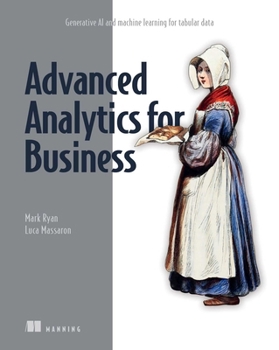Advanced Analytics for Business: Generative AI and Machine Learning for Tabular Data
Business runs on tabular data in databases, spreadsheets, and logs. Crunch that data using deep learning, gradient boosting, and other machine learning techniques. Machine Learning for Tabular Data teaches you to train insightful machine learning models on common tabular business data sources such as spreadsheets, databases, and logs. You'll discover how to use XGBoost and LightGBM on tabular data, optimize deep learning libraries like TensorFlow and PyTorch for tabular data, and use cloud tools like Vertex AI to create an automated MLOps pipeline. Machine Learning for Tabular Data will teach you how to: - Pick the right machine learning approach for your data
- Apply deep learning to tabular data
- Deploy tabular machine learning locally and in the cloud
- Pipelines to automatically train and maintain a model Machine Learning for Tabular Data covers classic machine learning techniques like gradient boosting, and more contemporary deep learning approaches. By the time you're finished, you'll be equipped with the skills to apply machine learning to the kinds of data you work with every day. Foreword by Antonio Gulli. Purchase of the print book includes a free eBook in PDF and ePub formats from Manning Publications. About the technology Machine learning can accelerate everyday business chores like account reconciliation, demand forecasting, and customer service automation--not to mention more exotic challenges like fraud detection, predictive maintenance, and personalized marketing. This book shows you how to unlock the vital information stored in spreadsheets, ledgers, databases and other tabular data sources using gradient boosting, deep learning, and generative AI. About the book Machine Learning for Tabular Data delivers practical ML techniques to upgrade every stage of the business data analysis pipeline. In it, you'll explore examples like using XGBoost and Keras to predict short-term rental prices, deploying a local ML model with Python and Flask, and streamlining workflows using large language models (LLMs). Along the way, you'll learn to make your models both more powerful and more explainable. What's inside - Master XGBoost
- Apply deep learning to tabular data
- Deploy models locally and in the cloud
- Build pipelines to train and maintain models About the reader For readers experienced with Python and the basics of machine learning. About the author Mark Ryan is the AI Lead of the Developer Knowledge Platform at Google. A three-time Kaggle Grandmaster, Luca Massaron is a Google Developer Expert (GDE) in machine learning and AI. He has published 17 other books. Table of Contents Part 1
1 Understanding tabular data
2 Exploring tabular datasets
3 Machine learning vs. deep learning
Part 2
4 Classical algorithms for tabular data
5 Decision trees and gradient boosting
6 Advanced feature processing methods
7 An end-to-end example using XGBoost
Part 3
8 Getting started with deep learning with tabular data
9 Deep learning best practices
10 Model deployment
11 Building a machine learning pipeline
12 Blending gradient boosting and deep learning
A Hyperparameters for classical machine learning models
B K-nearest neighbors and support vector machines
- Apply deep learning to tabular data
- Deploy tabular machine learning locally and in the cloud
- Pipelines to automatically train and maintain a model Machine Learning for Tabular Data covers classic machine learning techniques like gradient boosting, and more contemporary deep learning approaches. By the time you're finished, you'll be equipped with the skills to apply machine learning to the kinds of data you work with every day. Foreword by Antonio Gulli. Purchase of the print book includes a free eBook in PDF and ePub formats from Manning Publications. About the technology Machine learning can accelerate everyday business chores like account reconciliation, demand forecasting, and customer service automation--not to mention more exotic challenges like fraud detection, predictive maintenance, and personalized marketing. This book shows you how to unlock the vital information stored in spreadsheets, ledgers, databases and other tabular data sources using gradient boosting, deep learning, and generative AI. About the book Machine Learning for Tabular Data delivers practical ML techniques to upgrade every stage of the business data analysis pipeline. In it, you'll explore examples like using XGBoost and Keras to predict short-term rental prices, deploying a local ML model with Python and Flask, and streamlining workflows using large language models (LLMs). Along the way, you'll learn to make your models both more powerful and more explainable. What's inside - Master XGBoost
- Apply deep learning to tabular data
- Deploy models locally and in the cloud
- Build pipelines to train and maintain models About the reader For readers experienced with Python and the basics of machine learning. About the author Mark Ryan is the AI Lead of the Developer Knowledge Platform at Google. A three-time Kaggle Grandmaster, Luca Massaron is a Google Developer Expert (GDE) in machine learning and AI. He has published 17 other books. Table of Contents Part 1
1 Understanding tabular data
2 Exploring tabular datasets
3 Machine learning vs. deep learning
Part 2
4 Classical algorithms for tabular data
5 Decision trees and gradient boosting
6 Advanced feature processing methods
7 An end-to-end example using XGBoost
Part 3
8 Getting started with deep learning with tabular data
9 Deep learning best practices
10 Model deployment
11 Building a machine learning pipeline
12 Blending gradient boosting and deep learning
A Hyperparameters for classical machine learning models
B K-nearest neighbors and support vector machines
Format:Paperback
Language:English
ISBN:1633438546
ISBN13:9781633438545
Release Date:March 2025
Publisher:Manning Publications
Length:485 Pages
Weight:0.99 lbs.
Customer Reviews
0 rating





